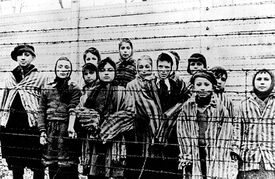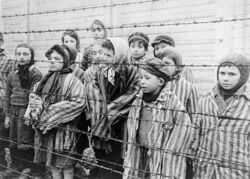Difference between revisions of "Ruth Webber"
| Line 57: | Line 57: | ||
[[Category:Krakow Orphanage (subject)|1935 Webber]] | [[Category:Krakow Orphanage (subject)|1935 Webber]] | ||
[[Category:Holocaust Children's Photos (subject)|1935 Webber]] | |||
Latest revision as of 13:08, 10 June 2021
Ruth Webber / Ruth Muschkies (F / Poland, 1935), Holocaust survivor
- <Auschwitz> <Liberation of Auschwitz> / <Krakow Orphanage> -- <Germany> <Canada> <United States>
Biography
Ruth was born in 1935 at Ostrowiec, Poland. She was four years old when the Germans invaded Poland and occupied Ostrowiec. Her family was forced into a ghetto. Germans took over her father's photography business, although he was allowed to continue working outside the ghetto. Before the ghetto was liquidated, Ruth's parents sent her older sister Helen into hiding, and managed to get work at a labor camp outside the ghetto. Ruth also went into hiding for some time, either in nearby woods or within the camp itself. When the camp was liquidated, Ruth's parents were split up. Ruth's father perished. Ruth and her mother was sent to several concentration camps before eventually being deported to Auschwitz. In October 1944, mother was sent to another camp and Ruth was transferred into Mengele’s children’s block, where she stayed until liberation on Jan 27, 1945.
After the war, Ruth lived in an orphanage in Krakow until she was reunited with her mother and sister. The three escaped to Munich, and immigrated to Toronto two years later to live with distant relatives. Ruth married Mark Webber in 1956 and moved to Detroit, Michigan.
Auschwitz Picture
She is present in an iconic Auschwitz picture, that depicts 13 child survivors, shortly after the liberation of the camp. All of them have been identified. From left to right they are:
- (1) Tomy Shacham / Tomy Schwarz (M / Slovakia, 1933)
- (2) Miriam Friedman / Miriam Ziegler (F / Poland, 1933)
- (3) Pessa Balter / Paula Lebovics (F / Poland, 1933)
- (4) Ruth Muschkies / Ruth Webber (F / Poland, 1935)
- (5) Bracha Katz / Berta Weinhaber (F / Slovakia, 1930)
- (6) Erika Dohan / Erika Winter (F / Czechia, 1931)
- (7) Marta Wise / Marta Slonim (F / Slovakia, 1934)
- (8) Eva Slonim / Eva Weiss (F / Slovakia, 1931)
- (9) Gabor Hirsch (M / Poland, 1929)
- (10) Gabriel Neumann / Gabriel Nejman (M / Czechia, 1937-2012)
- (11) Shmuel Schelach / Robert Schlesinger (M / Czechia, 1934-2006)
- (12 & 13) Eva & Miriam Mozes / Eva Kor (F / Romania, 1934-2019) and Miriam Zieger (F / Romania, 1934-1993).
USF Shoah Foundation
As a five-year-old, Ruth Muschkies Webber didn’t always understand what was happening when World War II began and Germans invaded her hometown of Ostrowiec, Poland. But when she saw the fear in her parents’ and grandparents’ eyes, she knew something was terribly wrong.
Ruth, born June 28, 1935, lived with her mother and father, a photographer. Her maternal grandparents lived close by and her paternal grandmother lived with them. Her older sister Helen was a piano prodigy who studied in a conservatory in Warsaw. In 1939, Germans invaded the town and her father’s studio was taken away soon after. Ruth remembers coming home one day to find her parents and grandparents crying – her grandfather had had his beard shaved off in the street. By 1940 the Ostrowiec ghetto was formed and their home became part of it. Helen returned from Warsaw and she and Ruth had to spend the majority of time inside their home with their grandparents. Ruth’s father, Samuel, used his connections within the gentile community to find a home for Helen to live and continue her education posing as a Christian orphan for the duration of the war. Ruth was too young at the time to safely follow the same route.
Ruth’s parents secured places for themselves at the Bodzechów work camp and smuggled Ruth in, where they hoped they would all be safe. Her grandparents and other family could not go and were eventually sent to Treblinka, where they were killed. Ruth hid wherever she could since children were not allowed in the camp, and would often go with her mother to the forest to avoid being transported to an extermination camp. Though she lived in constant fear of being discovered and shot on the spot, Ruth daydreamed about what life might be like if she could run and play like other children.
After being moved to various other ghettos and concentration camps, Ruth and her mother (her father had already been separated from them) were sent to Auschwitz in August of 1944. While her mother was selected for work, Ruth often hid in a barrack that was filled with corpses – she even played there, Ruth remembers, so accustomed was she to death. Ruth became sick with measles and pneumonia, and later with tuberculosis, but through the help of other prisoners and by hiding her symptoms she avoided being selected for the gas chambers. In October 1944 Ruth’s mother was sent out of Auschwitz on a transport to another camp leaving Ruth devastated.
In January 1945, the approaching Soviet Army triggered the Germans to send the majority of camp inmates on what would be death marches to lands that were still under German control. Ruth and other children, and the elderly and sick were left behind to be executed. The Red Army liberated them on January 27, 1945. Ruth and the other children were sent to an orphanage in Krakow to recover where her mother found her from a list of the children’s names posted at a train station. The two reunited with Helen and after 2 years in Munich Germany moved to Toronto in 1948 to live with distant relatives. Ruth’s father and 35 other immediate family members did not survive.
Ruth married fellow Holocaust survivor Mark Webber in 1956 and moved to his home in Detroit. They had three daughters, Shelly, Elaine and Susan, and five grandchildren. Ruth keeps in close touch with Miriam Friedman Ziegler and Paula Lebovics, who were also from Ostrowiec and are pictured in the photograph.

